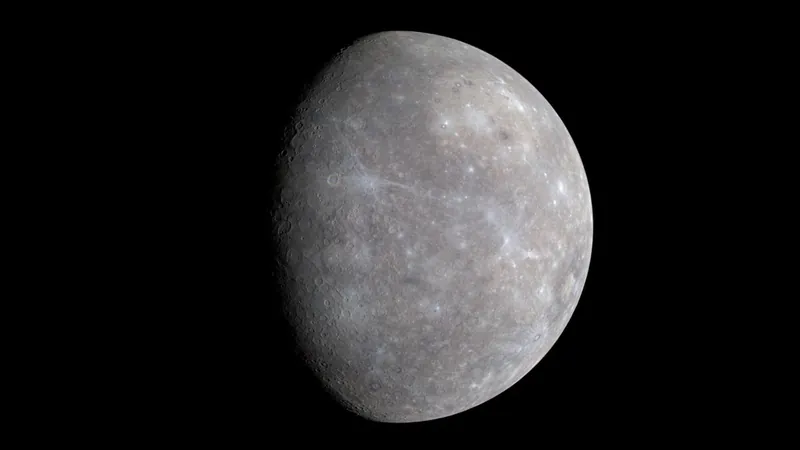
Groundbreaking York University Study Reveals Secrets of Earth’s Formative Years!
2025-03-26
Author: Li
Groundbreaking Research on Earth's Formation
In a significant breakthrough for planetary science, a pioneering study from York University has delved into the first 100 million years of Earth’s formation, shedding new light on the processes that shaped our planet's early structure. Led by Assistant Professor Charles-Édouard Boukaré from the Department of Physics and Astronomy, this research challenges long-held beliefs about how rocky planets evolve and solidify.
Foundation of Earth's Lower Mantle Established
Boukaré's study suggests that the foundational characteristics of Earth’s lower mantle were established shortly after the planet's formation, approximately four billion years ago. By integrating fluid mechanics with chemistry, this research stands out as one of the first to connect early geological processes directly to present-day mantle structures.
Significance of Mantle Dynamics
Key to this research is the mantle, the massive rocky layer encasing the Earth's iron core. The dynamics of the lower mantle are crucial for numerous geological phenomena, including the cooling of the planet's core, which drives the generation of Earth’s magnetic field. This magnetic field plays a vital role in shielding our planet from harmful solar radiation.
New Perspectives from the Study
The groundbreaking paper, titled Solidification of Earth’s Mantle Led Inevitably to a Basal Magma Ocean, was co-authored by Boukaré and a team of researchers from Paris. It offers a new perspective on how the evolution of Earth's interior has long-lasting implications for our understanding of geology.
Boukaré's Insight on Planetary Evolution
Boukaré likens the study of planets' evolution to analyzing the development of a child into an adult. "When we are young, our energetic conditions are vastly different, which can influence our growth and behaviors throughout life," he explains. "Similarly, the early energetic conditions of planets may have significant impacts on their structures today."
Innovative Methodology for Research
To investigate the ancient dynamics of the Earth’s mantle, Boukaré developed a novel multiphase flow model, enabling him to study how the mantle transitioned from a molten state to a solid one. This model revealed that many crystals in the early mantle formed at low pressure, leading to a distinct chemical signature that contrasts with the previously assumed high-pressure formation processes. This paradigm shift invites a reevaluation of how scientists understand the solidification process of rocky planets.
Implications for Future Planetary Studies
Boukaré emphasizes that this insight could pave the way for predicting the evolutionary trajectories of other planets. “With a grasp of the initial conditions and the primary processes influencing planetary evolution, we can better anticipate how different planetary bodies will behave over time," he said.
Broader Impact on Planetary Science
This groundbreaking research not only enhances our understanding of Earth’s history but also opens new avenues for studying planetary systems throughout the universe. As astrophysics continues to evolve, studies like Boukaré's will remain crucial for piecing together the puzzle of our planet's complex origins and its dynamic processes that govern life on Earth.
Artistic Renditions of Earth's Interior
For an artistic rendering of Earth’s interior shortly after its formation, showcasing the process of mantle solidification and the formation of a basal magma ocean, refer to the accompanying illustrations that vividly depict these early geological processes.
Conclusion and Future Updates
Stay tuned for updates as this research reshapes our understanding of planetary science and our place in the cosmos!




 Brasil (PT)
Brasil (PT)
 Canada (EN)
Canada (EN)
 Chile (ES)
Chile (ES)
 Česko (CS)
Česko (CS)
 대한민국 (KO)
대한민국 (KO)
 España (ES)
España (ES)
 France (FR)
France (FR)
 Hong Kong (EN)
Hong Kong (EN)
 Italia (IT)
Italia (IT)
 日本 (JA)
日本 (JA)
 Magyarország (HU)
Magyarország (HU)
 Norge (NO)
Norge (NO)
 Polska (PL)
Polska (PL)
 Schweiz (DE)
Schweiz (DE)
 Singapore (EN)
Singapore (EN)
 Sverige (SV)
Sverige (SV)
 Suomi (FI)
Suomi (FI)
 Türkiye (TR)
Türkiye (TR)
 الإمارات العربية المتحدة (AR)
الإمارات العربية المتحدة (AR)